The Render and the Real
Isaac Sullivan’s images-within-images, collected in cities around the world, reflect the complex entanglements of the virtual and the material in contemporary life.

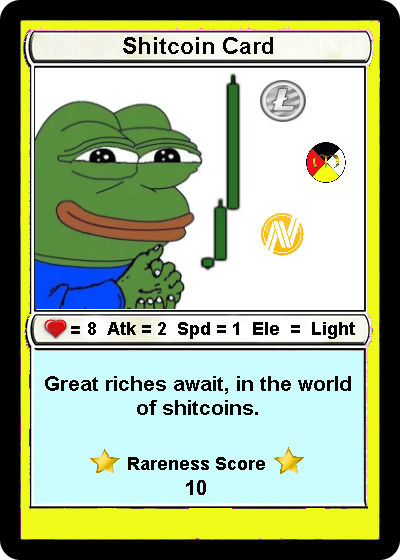
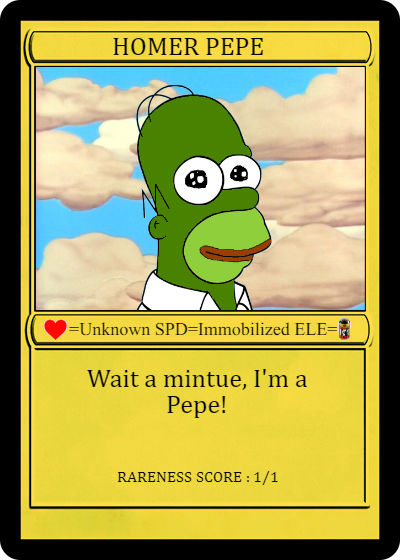
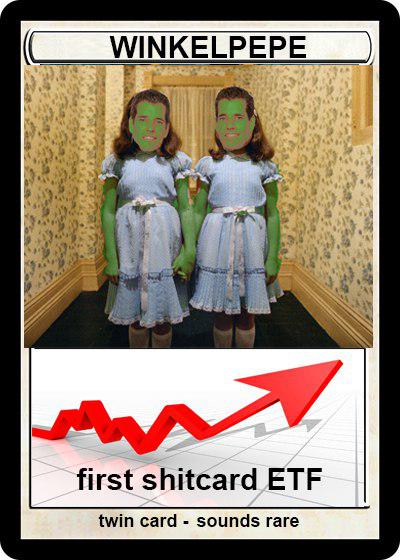
To truly appreciate crypto art, you have to embrace certain assumptions. One is that rarity is of the utmost importance. Another is that memes exert a huge influence on aesthetics. Rare Pepes marked a watershed moment in the formation of these norms. Based on one of the most iconic memes of all time, Rare Pepes were created and traded in a Bitcoin-based art community starting in 2016; the models pioneered in that community laid the foundation for the NFT collections of today.
Where did it all begin? In 2005, artist Matt Furie posted Playtime, a zine he made in Microsoft Paint, to MySpace. The comics told the story of a frog named Pepe and his slacker friends. In one panel, Pepe responds to a friend’s question by saying: “Feels good, man.” This image gained traction on 4chan, where it was turned into a meme in 2008. As the character appeared in more and more iterations of the meme, users began referring to the more unusual variations as “Rare Pepes.”
The models pioneered in the Rare Pepe community laid the foundation for the NFT collections of today.
Years later, users of Counterparty, a protocol built on the Bitcoin blockchain in order to create tokenized assets with smart contracts, recognized the potential of crypto technology for solidifying internet ephemera. In September 2016, “Mike” posted a Rare Pepe card to the Counterparty Telegram channel and said it paired with a Counterparty token. Members of the chat saw how producing frog pictures on the protocol to prove their digital scarcity would supercharge the Rare Pepe joke. At the time there was no foreseeable financial benefit. It was simply about making and trading “rare” objects with internet friends.
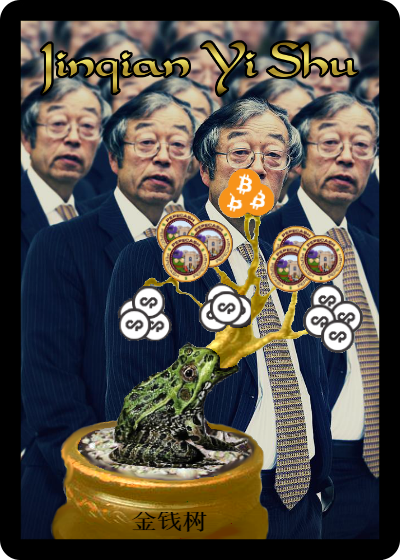
This first Rare Pepe was mined in block 428,919 on the Bitcoin blockchain. It was the now legendary Nakamoto card, available in an edition of 300. At the time, few people were exploring the idea of tokenizing assets. There was Ascribe, the first marketplace for crypto art built on Bitcoin, which officially launched in 2015 (XCopy released some of his early work there, much of which is lost today). Spells of Genesis, a fantasy-themed mobile card game also released in 2015, is credited as the first large-scale project to issue NFTs on Counterparty. Of course, all of this happened before tokenized assets on Ethereum, like CryptoPunks, which were released in June 2017, and CryptoKitties, released in September 2017.
But the real innovation of Rare Pepes was the reliance on user-generated content. It’s based on a meme, after all. A new Telegram chat was created because people wanted to pair their Rare Pepes with Counterparty assets. Counterparty’s protocol was not designed for sharing images, so community member Joe Looney adapted BTCPAY, a Counterparty marketplace he developed, to create an app called the Rare Pepe Wallet. This became a platform solely dedicated to the creation and trade of Pepes—far ahead of its time in terms of specialized NFT marketplaces.
Each potential Pepe was uploaded to a bot and sent to a private Telegram room where a small group called the “Rare Pepe scientists” would vote and make sure an image fit the criteria. Submissions had to have the correct dimensions, be “safe for work,” and involve Pepe in some way. In total, 1,774 cards by more than 300 artists were approved over the 18 months the project was in operation. This method removed the technical barriers to creating crypto art by automating the process—another substantial innovation for the time.
The crowdsourcing of submissions also meant that there was an incredibly wide swath of subject matter. It’s hard to pick a thematic throughline (besides the Pepe imagery), but, perhaps unsurprisingly, cards featuring crypto motifs were consistent throughout as well as political-leaning subject matter. There was an entire series of Putin-themed cards; Trump and Hillary Clinton pop up, too. These sit alongside a handful of Satoshi Nakamoto cards and others that feature Bitcoin OGs like the Winklevoss twins and Andreas Antonopoulos.
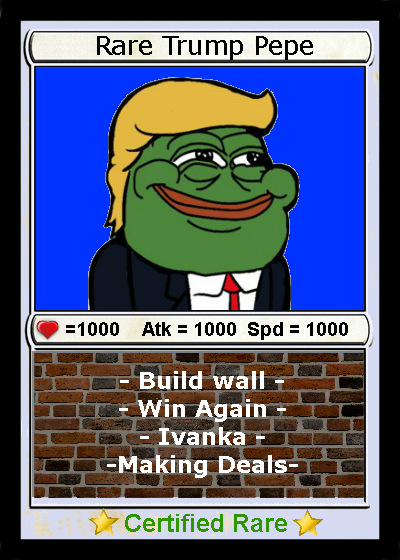
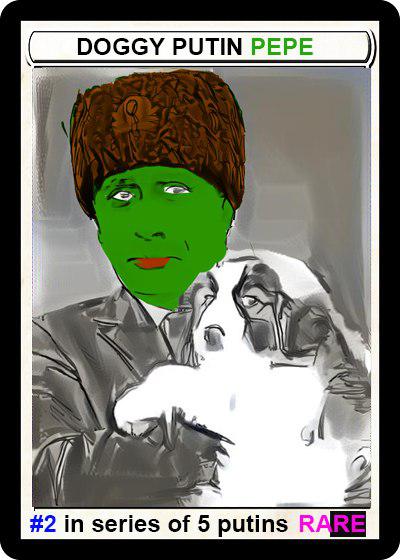
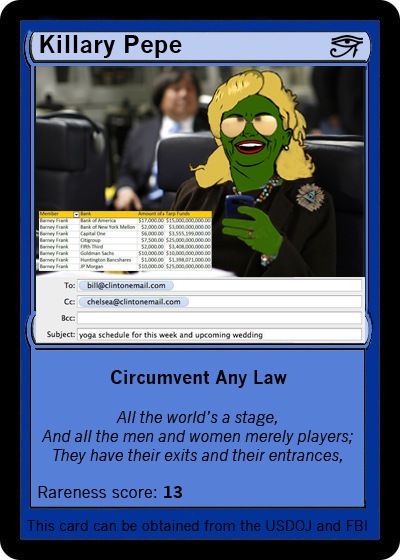
With all the advancements that the Pepe community made, there were still some haunting associations they had to navigate. The Anti-Defamation League added Pepe the Frog to its database of hate symbols for its usage by alt-right groups in 2016, shortly after Mike uploaded the first card. In an interview for Artnome’s blog, Joe Looney described the mood in response: “So it was almost lie, here’s this awesome thing, let’s do it! And then it’s like, aww, someone ruined Pepe!” However, by 2019, Pepe was being used as an icon by pro-democracy protesters in Hong Kong. These varying allegiances speak to the malleability of memes.
Even amid the controversy, the community remained strong, continuing to crank out takes on the famous green character. In total, there were 36 series of Rare Pepes, each containing 50 unique cards (besides the last series, which contained 24) of varying edition sizes. Creators could issue anywhere from a single edition to 1 billion. For instance, WINKLEPEPE was an edition of two (of course!) and there were 400 TRUMPRARE cards. Considering these numbers, it’s clear that not everyone aimed to maximize rareness in order to sell cards for large sums. Instead, it was common to release cards in editions of several hundred, so the whole community could collect them together. But, considering Bitcoin’s historic price run in 2017 and the position of Rare Pepes in NFT history, high sale prices for the best (and rarest!) cards became inevitable.
As creation of the cards became easier, it was more important to foster an engaged network of artists and collectors.
As creation of these cards became easier, it was more important to foster an engaged network of artists and collectors. To that end, community members introduced some significant innovations. It’s not often mentioned in Rare Pepe lore, but the community had their own currency. It was called Pepe Cash (not to be confused with $PEPE, a meme coin launched on Ethereum in April 2023). Rare Pepes were also traded with XCP, the Counterparty token, but Pepe Cash made it a self-contained, self-sustaining ecosystem. Looney called Pepe Cash “an in-game currency,” which speaks to its key role in building this all-encompassing Pepe-only world. Of course, now it is commonplace for an NFT project to release a corresponding currency, such as $APE for Bored Apes and $MEME for Memeland, to provide liquidity to early holders. But Pepe Cash was the first instance of this device, and the emphasis was on building up in-world lore and a sense of community ownership rather than on financial rewards.
Another under-the-radar advancement in the Rare Pepe community was experimentation with what is now called token-gated content—media that you can only access by owning a certain NFT. Internally, it was called “VIP content” and it usually included songs and video games. If you owned the DJPEPE card (Series #4, Card #29, edition of 169) by Rare Scrilla, you could click on it to get to a private SoundCloud page account with exclusive tracks by the artist. This was a massive step forward in terms of creating an “extra rare” experience via ownership, and a strategy commonly used by NFT projects subsequently.
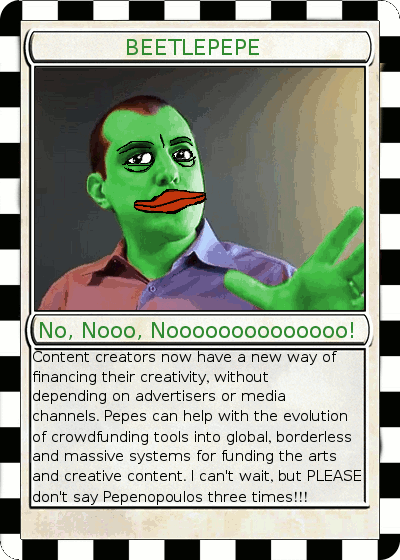
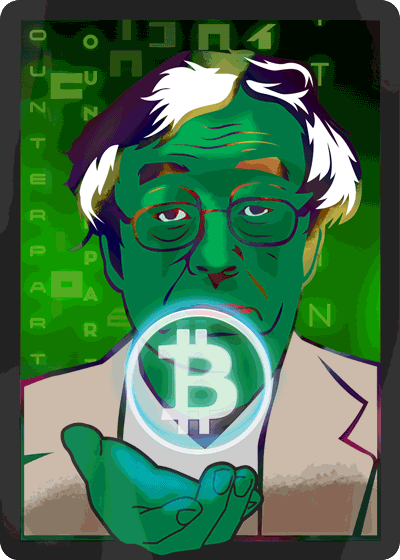
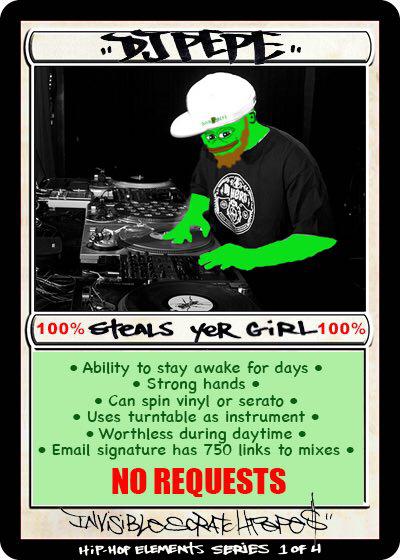
A breakthrough Pepe sale took place in January 2018, when HOMERPEPE—one of the few Rare Pepes to be issued as a one-of-one— sold for 39,000 USD at the Rare Art Labs’ Rare Digital Art Festival in New York. This was proof that rare, historic NFTs doubling as memes could be, in fact, an investment. And the buyer, Peter Kell, wasn’t part of the initial community, signaling that Rare Pepes had entered a new era of visibility and positioning as a financial asset. The card resold three years later to renowned collector Token Angels for 320,000 USD, who also was not part of the original group chat (at least not under this alias). In October 2021, another one-of-one Pepe called PEPENOPOULOS (2016) sold at Sotheby’s for 3.65 million USD, the highest sale of the NFT-only auction. This was the ultimate validation that memes could be monetized and sold at the world’s most prestigious venues. Rare Pepes had officially became collector’s items, not just items to collect for fun.
Even though Rare Pepes officially closed for submissions in 2018, citing high Bitcoin gas fees, the community is still incredibly strong. Arguably, the most recognizable Rare Pepe is the first of the entire series the aforementioned Nakamoto card, made by Mike. It’s Series #1, Card #1 in an edition of 300, meaning it has some liquidity. Editions periodically trade for over 100,000 USD. And in 2021 Rare Scrilla started a derivative project called Fake Rares, complete with a Looney-made “Fake Rare Wallet.” The Fake Rare community remains active today, trading art and holding events.
Bitcoin has become home, once again, to artistic innovation and unique aesthetic values.
The interest in art projects on Bitcoin has increased immensely since January 2023. The explosion of Ordinals inspired a cultural shift, with collectors and artists going (back) to Bitcoin and reimagining its creative possibilities. The blockchain has become home, once again, to artistic innovation and unique aesthetic values. Rare Pepes will always be important to consider as part of the origin story of crypto art, and Bitcoin art, in particular. In a space that moves so fast, history can be helpful in reminding us that memes weren’t always seen as art, rarity didn’t always equate to value, and community-building came before economic profit.
Blake Finucane hosts the Context podcast for Boys Club. In 2018 she wrote a master’s thesis in art history on early crypto art.
